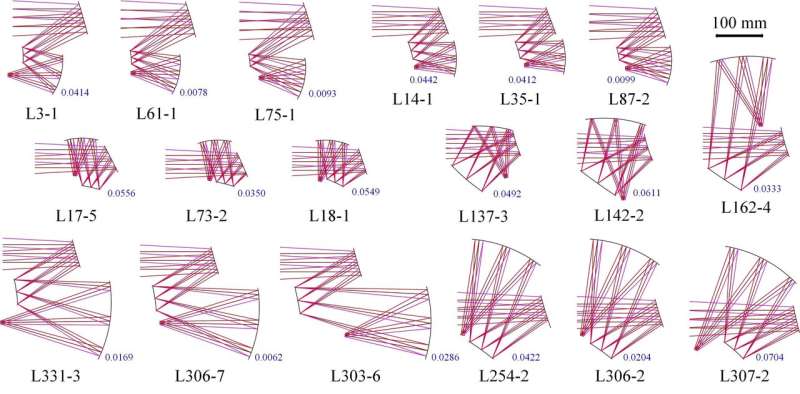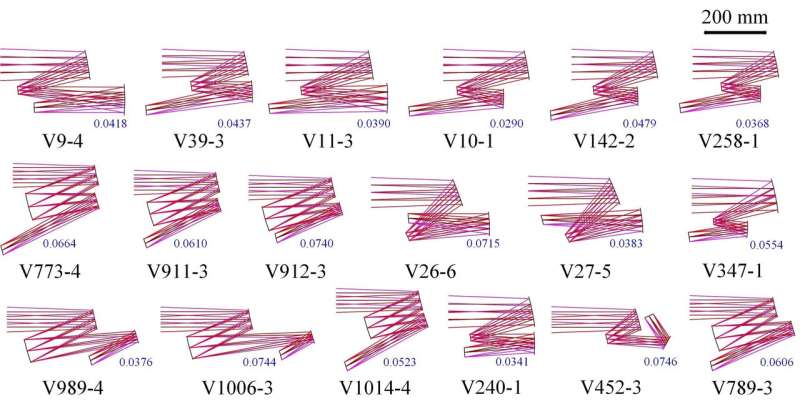The first design example is a three-mirror freeform imaging system that has a field-of-view of 8°×6°, a focal length of 50 mm and a F-number of 1.8, which works in the LWIR band. The computing task is deployed on the high-performance computing platform in Tsinghua University. Through 41.8 hours of automatic computation, 127 systems are obtained, all of which have the average RMS wavefront error (AVG WFE RMS) smaller than 0.075λ (λ = 10 μm). The imaging quality is considered to be diffraction-limited or near-diffraction-limited. Credit: Benqi Zhang, Guofan Jin and Jun Zhu
Designing an optical system requires of the designer significant effort, knowledge, skills and experience. In this work, an automatic design method is proposed for freeform optics, in which specifications and constraints are the only inputs required, and a variety of results can be obtained automatically. The output results have various structures and optical power distributions with high imaging qualities. By implementing this method, designers can realize an overview of the solution space and also focus on specific designs.
In the early days of optical design, people had to be proficient in aberration theory and perform a huge amount of numerical calculations, and thus mathematical skills and talents are very important. The emergence of electronic computers has freed people from heavy calculation tasks, and realized fast real ray tracing and been able to solve complex aberration equations. Since then, the application and development of optimization algorithms and optical design software have greatly improved the speed and effect of optical design. However, optical design still requires solving or finding an initial solution as the starting point of optimization, which will greatly determine the final result of optimization. Moreover, optimization is essentially a process of trial-and-error, and the effect of optimization is closely related to the experience of the designer. Therefore, optical design is both an art and a science.
Although there are more and more automated tools, optical design without human guidance is generally considered impossible. The future optical design we look forward to will be: input the system's specifications and constraints at the beginning of the design, and then a large number of high-quality design results with various structures can be automatically outputted. The main job of the designers will be to comprehensively consider factors such as manufacturability, system structure, etc., and select the final design from the output results.
The second design example is a three-mirror freeform imaging system that has a field-of-view of 4°×4°, a focal length of 450 mm and a F-number of 9, which works in the VIS band. Through 35.3 hours of automatic computation, 59 systems are obtained, all of which have the AVG WFE RMS smaller than 0.075λ (λ = 587.6 μm). Credit: Benqi Zhang, Guofan Jin and Jun Zhu
Towards this ultimate goal of optical design, in a new paper published in Light Science & Application, a team of scientists, led by Professor Jun Zhu from State Key Laboratory of Precision Measurement Technology and Instruments, Department of Precision Instrument, Tsinghua University, China, have developed a result-diversified automatic design method for freeform optics. With the system's specifications (field-of-view, focal length, entrance pupil diameter) as the only input, a variety of three-mirror freeform imaging systems are obtained automatically, which have various structures and diffraction-limited high imaging qualities. This function is realized for the first time in the field of optical design.
The proposed method is able to perform a coarse search of the solution space of three-mirror freeform systems to obtain a wide variety of high-quality systems, so that one can have an overview of the solutions. This method is also feasible to let one focus on specific designs and conduct fine searches to obtain more similar designs or designs with higher imaging qualities. Through different levels of coarse and fine searching, more and better freeform designs could emerge.
The specifications of the third design example are challenging. The three-mirror freeform imaging system has a field-of-view of 4°×4°, a focal length of 600 mm and a F-number of 3, which works in the VIS band. Through 22.2 hours of automatic computation on a working station, 48 systems with the are obtained with the AVG WFE RMS smaller than 0.30λ (λ = 587.6 μm). The best AVG WFE RMS in the coarse search is 0.11λ. Taking the system with the best imaging quality as the center, a fine search is conducted and system with the AVG WFE RMS smaller than 0.075λ is eventually obtained, as shown by V2-885-1-34-1. The five systems shown in this figure have the AVG WFE RMS smaller than 0.11λ. Credit: Benqi Zhang, Guofan Jin and Jun Zhu
The result-diversified automatic design method proposed in this research provides a brand new appraoch for the realization of fully automatic optical design. It enables people to obtain a variety of high-quality designs with only basic knowledge of optical design. In the field of scientific research, people can explore the solution space of optical systems and the boundaries of system's performance based on the massive results obtained, or conduct research on the disciplines of optical design. In the field of engineering applications, optical design tools based on the proposed method are expected to change the working mode and core content of optical design. Designers can focus on system specification, manufacturability, and cost, etc.
More information: Benqi Zhang et al, Towards automatic freeform optics design: coarse and fine search of the three-mirror solution space, Light: Science & Applications (2021). DOI: 10.1038/s41377-021-00510-z
Provided by Chinese Academy of Sciences


























